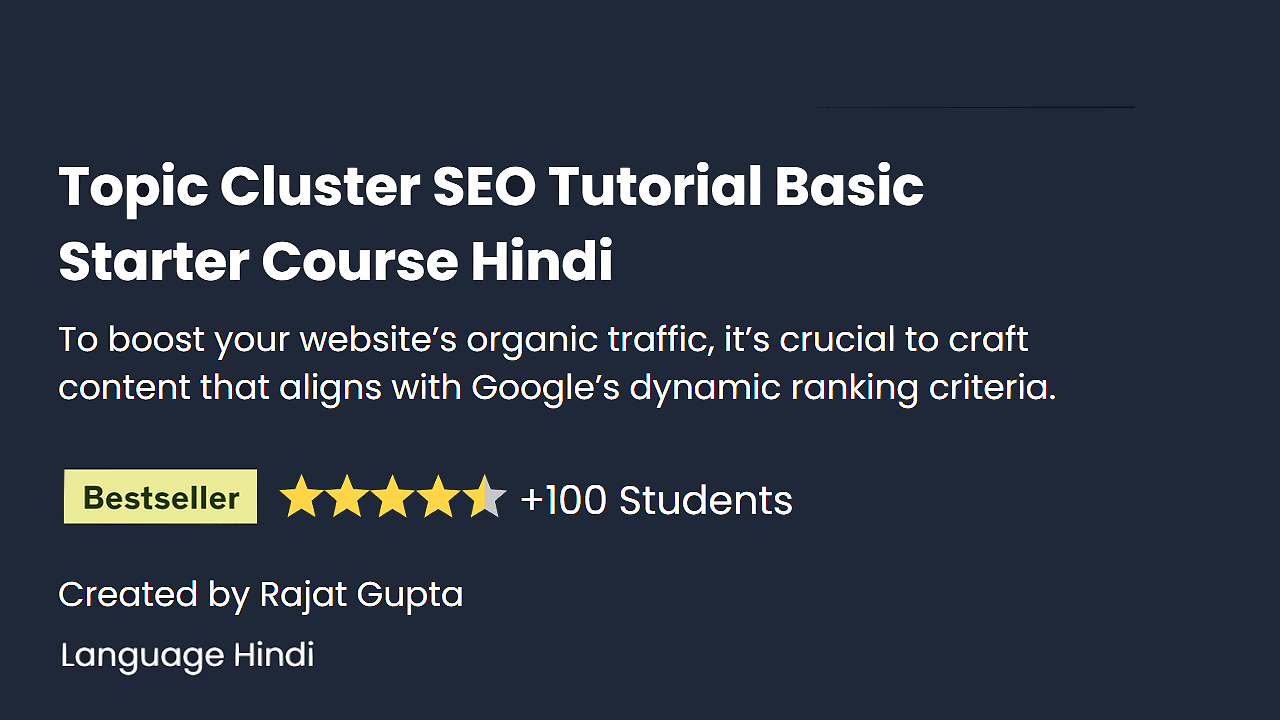Step-by-Step Guide to Topic Cluster SEO Success in 2025
As the digital landscape continues to evolve, search engine optimization (SEO) remains a vital strategy for improving website visibility and attracting organic traffic. Read more about Step-by-Step Guide to Topic Cluster SEO Success in 2025
Step-by-Step Guide to Topic Cluster SEO Success in 2025
So as per this Step-by-Step Guide to Topic Cluster SEO Success in 2025 article, As the digital landscape continues to evolve, search engine optimization (SEO) remains a vital strategy for improving website visibility and attracting organic traffic.
In 2025, the SEO world is shifting towards more sophisticated content strategies, and one of the most effective approaches gaining momentum is topic cluster SEO.
This method not only boosts your search engine rankings but also helps you deliver more organized, user-friendly content.
In this Step-by-Step Guide to Topic Cluster SEO Success in 2025 guide, we will walk you through a step-by-step approach to mastering Topic Cluster SEO in 2025, and explain how you can leverage this strategy to improve your SEO success.
What is Topic Cluster SEO?
So based on this Step-by-Step Guide to Topic Cluster SEO Success in 2025 article, Topic clusters are a way to organize your content to improve its relevance to both users and search engines.
A topic cluster consists of a pillar page (a comprehensive, authoritative piece of content on a broad topic) and multiple cluster pages (supporting content that links back to the pillar page).
By organizing content using this Topic Cluster SEO Strategies 2025 Guide, into these clusters, you signal to search engines that your site covers a subject in-depth, improving your site’s authority and relevance on that topic.
Key Components of Topic Cluster SEO:
- Pillar Page: A detailed, long-form article that covers a broad topic in great depth. The pillar page serves as the cornerstone for the topic cluster and links to all related cluster pages.
- Cluster Pages: These are individual pages that focus on specific subtopics related to the pillar page. Cluster pages should link back to the pillar page, creating a strong internal linking structure.
- Internal Linking: Linking cluster pages to the pillar page, and vice versa, helps establish a clear site hierarchy that search engines can easily crawl and index.
Why Topic Clusters Matter for SEO in 2025
So as guided in this Step-by-Step Guide to Topic Cluster SEO Success in 2025 article, In 2025, search engines like Google are becoming increasingly sophisticated, relying more on semantic search and contextual relevance.
Topic Cluster SEO Trends Best Practices 2025 or Traditional SEO strategies that focus solely on keywords are no longer enough to rank well. Topic clusters help organize your content in a way that appeals to modern search engine algorithms.
Benefits of Topic Cluster SEO:
- Improved Search Engine Rankings: When you create a topic cluster, you make it easier for search engines to understand your content and how it’s related to other content on your site. This helps improve your rankings for broader, more competitive keywords.
- Better User Experience: Topic clusters provide a clear structure, making it easier for users to find relevant information. This leads to longer time spent on your site and lower bounce rates—both important ranking factors.
- Higher Authority in Your Niche: By creating comprehensive pillar pages and supporting cluster content, you establish yourself as an expert on a given topic, which can increase your site’s authority and trustworthiness in the eyes of both users and search engines.
- Increased Organic Traffic: Topic clusters help drive more organic traffic because they target a broader range of related long-tail keywords, capturing users searching for specific subtopics.
Step 1: Choose Your Pillar Topics
So according to this Step-by-Step Guide to Topic Cluster SEO Success in 2025 article, Before diving into creating content, you need to select your pillar topics. These topics should be broad and highly relevant to your business or niche. In 2025, focus on creating pillar pages that address long-tail keywords with high search intent.
How to Choose a Pillar Topic:
- Keyword Research: Use tools like Google Keyword Planner, SEMrush, or Ahrefs to find high-traffic keywords related to your business. The pillar topic should be something broad enough to encompass several subtopics.
- Relevance: Ensure that the pillar topic is relevant to your audience’s needs. For example, if you run a blog about SEO, a good pillar topic could be “The Ultimate Guide to SEO Strategies.”
- Search Intent: Focus on topics that align with search intent. Is the audience looking for informational content, products, or services? Ensure your pillar topic addresses these needs.
- Competitor Analysis: Look at what your competitors are doing. Identify their top-ranking pillar pages and see how you can improve upon them by offering more in-depth, valuable content.
Step 2: Create a Comprehensive Pillar Page
So considering this Step-by-Step Guide to Topic Cluster SEO Success in 2025 article, The pillar page serves as the foundation of your topic cluster. It should be a long-form, comprehensive piece that covers the pillar topic in detail and links out to the cluster pages.
How to Create a Pillar Page:
- Length and Depth: A pillar page should be at least 1,500-2,000 words, thoroughly covering the subject. Don’t just scratch the surface—provide valuable insights, examples, and actionable tips.
- Organized Structure: Break the content into digestible sections with clear subheadings. Use a table of contents at the beginning to improve the user experience.
- Internal and External Links: Link to cluster pages (which cover subtopics) and authoritative external sources (like industry studies or expert articles) to boost the page’s credibility.
- Multimedia: Enhance your pillar page with relevant images, infographics, videos, or downloadable resources like e-books or checklists. This not only improves the user experience but also keeps readers engaged longer.
Step 3: Develop Cluster Pages
Topic Cluster SEO 2025 How It Boosts Website Traffic : Once your pillar page is live, it’s time to create your cluster pages. These pages should each cover specific subtopics that link back to the pillar page.
How to Create Cluster Pages:
- Subtopic Relevance: The cluster pages should focus on highly specific subtopics that are still related to the main pillar topic. For example, if your pillar page is about “SEO Strategies,” a cluster page could cover “On-Page SEO Best Practices” or “How to Build Quality Backlinks.”
- Keyword Optimization: Just like pillar pages, optimize your cluster pages for specific long-tail keywords. Use LSI keywords (Latent Semantic Indexing) that Google recognizes as contextually related to your pillar topic.
- Internal Linking to Pillar Page: Make sure each cluster page includes a prominent link back to the pillar page. This reinforces the hierarchical relationship between the pages.
- Actionable Content: Offer practical advice, tools, or resources that solve specific problems. Cluster pages should add value and encourage users to read more content on your website.
Step 4: Implement Effective Internal Linking
Master Topic Cluster SEO for Better Ranking in 2025 : Internal linking is the backbone of topic cluster SEO. It’s how you connect your pillar page and cluster pages, making it easy for search engines to crawl and understand the structure of your site.
How to Implement Internal Linking:
- Link from Cluster to Pillar: Every cluster page should link back to the pillar page, usually in the introduction or conclusion. This boosts the pillar page’s authority and relevance.
- Cross-Linking Between Clusters: In addition to linking back to the pillar page, you can link related cluster pages to each other. For example, if you have a pillar page about SEO Strategies, link between the cluster pages on On-Page SEO and Content Marketing to show how these strategies are interconnected.
- Anchor Text: Use descriptive anchor text when linking to the pillar page or other cluster pages. Avoid generic text like “click here”—instead, use phrases like “learn more about SEO keyword strategies.”
Step 5: Optimize for User Experience and Technical SEO
But Why Topic Cluster SEO is Essential for 2025 Success, While content and internal linking are essential, user experience (UX) and technical SEO are equally important in 2025.
Key Areas for UX and Technical Optimization:
- Mobile Optimization: Ensure that your pages are mobile-friendly. Google’s mobile-first indexing means that your website’s mobile version is prioritized in search rankings.
- Page Speed: A fast-loading website is crucial for SEO success. Use tools like Google PageSpeed Insights to identify areas where your site can be improved.
- Structured Data Markup: Implement schema markup to help search engines understand your content. This can lead to better rankings and enhanced snippets in search results.
- User Engagement: Encourage users to leave comments, share your content on social media, and engage with your site. High user engagement signals to Google that your content is valuable and relevant.
Step 6: Monitor, Update, and Scale Your Topic Clusters
SEO isn’t a one-time effort; it’s a continuous process. In 2025, it’s important to regularly monitor your topic cluster performance and make updates as needed.
How to Monitor and Update Topic Clusters:
- Track Rankings: Use SEO tools like Google Analytics, SEMrush, or Ahrefs to track your rankings for the keywords related to your pillar and cluster pages.
- Update Content: SEO strategies and trends change over time. Ensure that your pillar and cluster pages are updated regularly to reflect the latest developments and maintain relevance.
- Expand Clusters: As you grow your content library, keep expanding your topic clusters. Add more cluster pages to deepen your coverage of related subtopics and target additional long-tail keywords.
Conclusion About Step-by-Step Guide to Topic Cluster SEO Success in 2025
Topic cluster SEO is a powerful strategy for achieving success in 2025. By following this step-by-step guide, you can create a robust content structure that enhances both your user experience and search engine rankings.
With the right combination of keyword optimization, internal linking, and high-quality content, topic clusters can help you dominate your niche, drive more organic traffic, and build lasting authority in your industry. Start implementing topic clusters today and watch your SEO results soar in 2025! So this concludes the article about Step-by-Step Guide to Topic Cluster SEO Success in 2025!

